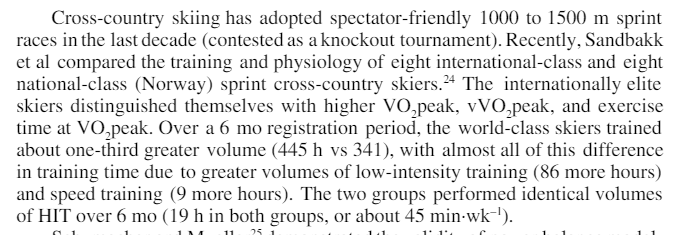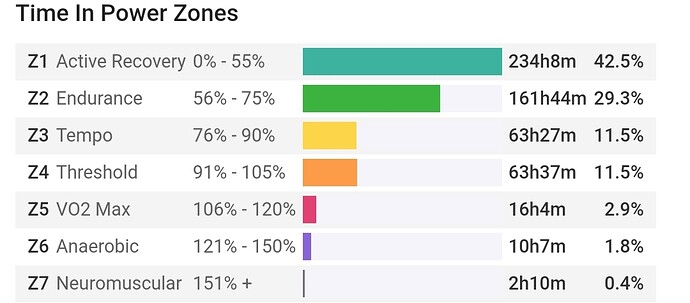When you’re training 20+ hours per week, I don’t think you have any other choice.
Bingo
Well the athletes in this particular situation were training between 13 and 16 hours.

445 divided by 26 is 17 and change.
Regardless, the point stands that there is only so much high intensity training that you can do, so anything beyond that must be lower intensity.
IOW, a polarized or even pyramidal TID is an effect, not a cause.
Except you were saying you can’t add any more intensity to 20+ hour weeks.
That comparison is between 13 hour weeks and 17 hour weeks. Saying you can’t add intensity to 20+ hour weeks is a lot different than saying you can’t add it on to a 13 hour week.
20+ hour per week (730+ hours per year) was really just an arbitrary number, 'cause that’s how much folks at higher levels tend to train in all endurance sports. The sprint skiers you brought up are an exception.
In any case, I’d say that on even 13 hours per week many- but not all - individuals are going to have to figure out how to balance intensity and volume. A rule-of-thumb like 80:20 might be helpful to some, but unfortunately too many folks view it as goal unto itself, when in fact your TID is just a result, not a means to an end.
To some extent there’s some truth to this. But it only applies figuring out the limit % of the high intensity part. When I’m riding outside, things are more of a function of the route I want to do. In this example, I was coming from a recovery week, so I planned for:
A 30-45m steep climb on Monday
A long climb (60min) on Thursday (Gravel)
A century (Gravel/Road) on Sunday
Never thinking about zones or structure. The end result: Pyramidal

It’s still just a result, not anything you specifically aimed for?
old_but_not_dead_yet: this is an interesting observation.
The observation that has not been factored into this discussion relates to the number of training days / week and how we conceive of them. To illustrate:
[A} is a person who trains 3.5 hours / wk = 5 hrs / 10 days (this makes the maths easier). His/her rule 1 is – no more than 2 HIT sessions per 10 days. His/her rule 2 is – no Z2. Result = anti-POL, or 2 HIT sessions + 1-2 Z1 sessions every 10 days.
[B} trains 21 hrs / wk = 30 hrs / 10 days. Same rules. Result = ~POL, or 2 HIT sessions + 6-7 Z1 rides.
In other words, as OBNYD indicates, POL is an outcome of the same rule applied to two different training scenarios. If we count non-training days, then [A] and [B] have the same training distribution, namely 2 HIT + 8 <= Z1 sessions per 10 days. Part of the problem with identifying POL in low-volume training is that we do not count non-training days as <= Z1.
Some variant of rule 1 is widely accepted – no more than ~2 HIT sessions / wk. The question concerns rule 2 – no Z2. In other words, it’s not that POL is 80/20 or whatever we are arguing about, because that’s just a function of rule 1 + training time; it’s that POL is little/no Z2.
Sorry didn’t read through the whole tread so ignore if already discussed.
This is my breakdown in power zones of strictly doing trainer road mostly mid volume sweet spot plans with some z1 z2 rides thrown in when I felt like I needed more. Doesn’t seem too far from the 80:20 breakdown at least as far as pure time is considered.
I think you got it a bit mixed up. 80:20 (polarized training) refers rather to the number of training sessions. The time in Zone would be rather 90:10 because you still have rest time between Intervalls plus warm Up / cool down in your hard sessions.
And if we are talking about polarized training there would be next to no Z3 and probably also way less Z4 (only upper Z4) and more Z5.
Also at least for running, recovery time between intervals is considered part of the 20 since your heart rate is still elevated. Think the same could be said for cycling?
That might be close to 80:20 training based on TiZ but 80:20 does not equal POL (although it might sometimes) Also as has been stated ^ POL is by sessions.
My running training is 80/20 TiZ and almost by session (well 79/21), but not POL
79% → Z1 (mainly classic 5 zone Z1 and slightly less Z2)
21% → Z3 (20% classic 5 zone Zone 3) + Z3 (1% classic Zone)
I take a similar approach and my season is:
Strength work>Slow>Sweetspot>Pol…(ish)
If you had read the thread, you’d know that TIDs aren’t based on TiZ, but if they were, yours would be PYR, not POL. ![]()
So basically everything that included more Z2 than hard work works better… pyramidal and polarized yeld almost the same results. So your hard work 2 or 3 times a week and rest is Z2.
bet you didn’t see this can of worms getting popped open!
No need IMO to choose ONE or the other; use all training zones in a consistent and progressive manner that align with your goals as a cyclist in terms of events, strengths and weaknesses, and you will get stronger and faster!!!
Good luck!
Got it, thanks all! ![]()
![]()
I bet Backwards Hat Dylan is happy for the free 40mins of read-time marketing this thread is giving Coach Dylan. ![]()
